
![[ISCEV logo]](../../images/logo74.gif)
| WWW.ISCEV.ORG | Standards | Links |  |
![[ISCEV logo]](../../images/logo74.gif) |
|||
| Events | Books & Archive | Misc | |||||
| Newsletters | Members | About |
|
Address of the ISCEV website:
This newsletter is published on paper (in grey) and on the web (in colour).
To improve future newsletters, send nice and thoughtful feedback to Michael Bach, michael.bach@uni-freiburg.de |
| President's Message | top ↑ | ||||
|
|||||
| Secretary-General | top ↑ | ||
| |||
| ISCEV Treasurer's Report: 01 Jan 2000 - 31 Dec 2000 | top ↑ | ||||||||||||||||||||||||||||||||||
|
|
||||||||||||||||||||||||||||||||||
| Eimiko Adachi, ISCEV Treasurer | |||||||||||||||||||||||||||||||||||
| Elections | top ↑ |
|
|
|
| Regional reports | top ↑ | ||||||
|
ASIA-AUSTRALIA
EUROPE-AFRICA
|
|||||||
| Minutes of the membership meeting in Sydney, Australia | top ↑ |
|
1. Opening by the President The meeting is opened at 10.30, 15 February 2000 by the President, Professor Miyake. 159 members are present. 2. Minutes of the 1999 meeting The minutes of the 1999 Membership Meeting are accepted as a true record and signed as such by the President. There are no matters arising. 3. Report of the Secretary-General The Secretary-General (Professor Barber) presents his report for 1999, which has been published in the Newsletter. There are no matters arising from it. 4. Report of the Treasurer The Treasurer (Professor Adachi) presents her report for 1999. She informs the meeting that henceforth membership dues will be stated and paid in USD. The Secretary-General then initiates discussion on the membership fee, currently $110. He points out that it has not been increased during his entire term of office as Secretary-General, but that a number of relatively expensive improvements in the service to members have been introduced during this period. He cites the introduction of mail balloting and the sending of the Abstracts Book to all members who are not able to attend the symposium. He reports that the Board proposes an increase of $25 pa, to come into effect on 1 January 2001. After discussion, a vote is taken. Voting takes place with the following result: For 158, Against 0, Abstention 1. The proposal is accepted. 5. Report of the Editor The Editor (Dr Odom) gives his annual report, which has been published in the Newsletter. He asks that members note that manuscripts should now be sent directly to the publisher, Kluwer, rather than to him. 6. Proposals to change the Bye-laws The Secretary-General draws to the attention of the meeting the proposals to change the bye-laws, which were published in the “News Extra” circulated to members in July 1999, and which are reprinted in the Abstracts Book. He explains the reasons for the Board putting forward these proposals: 6.1 Proposal to define the number of Members-at-Large on the Board of Officers This proposal specifies the number of Members-at-Large, and introduces
some regional constraint. Article VI: Officers Voting takes place with the following result: For 158, Against 0, Abstention 1. The proposal is accepted. 6.1A Rider to Proposal 1: Implementation The position of Board Member-at-Large exists to provide experience of
working on and with the Board to members who may wish to serve ISCEV as
executive Officers. The aim of this proposal is to ensure a steady supply
of such experienced members, and with a reasonably uniform geographical
distribution. However, if the proposal were enacted immediately, it would
cause problems with phasing: too man Board Members-at-Large would change
at the same time, which would be contrary to the spirit of the proposal.
It is therefore suggested that, taking into account the existing number
of Members-at-Large, and their expiry dates, one additional Member-at-Large
be elected in 2001, and another in 2003. Voting takes place, the proposal is accepted unanimously. 6.2 Proposal to change the status of the position of Secretary-General This proposal changes the status of Secretary-General from an elected
to an appointed Officer of the Board.
Voting takes place with the following result: For 157; Against 0, Abstentions 2. The proposal is accepted. 7. Elections The President announces that elections are needed for the following Board positions: 7.1 Vice-president (Asia/Australia) Position vacated by Miyake Miyake presents the Board's candidates, Oguchi and Wu, and asks if there are further nominations from the floor. There are none. In the absence of the two candidates, the meeting approves by the majority of > 50% each of these candidates, and so Oguchi and Wu will go forward to a mail ballot of all members eligible to vote. 7.2 Vice-president (Europe/Africa) Position vacated by Galloway who is not eligible for re-election, having served two terms. Miyake presents the Board's candidate, GFA Harding, and asks if there are further nominations from the floor. There are none. In the absence of the candidate, the meeting votes. Harding is elected unanimously 7.3 Secretary (Europe/Africa) Position vacated by Barber Miyake presents the Board's candidates, Kellner and Tormene, and asks if there are further nominations from the floor. There are none. In the absence of the two candidates, the meeting approves by the majority of > 50% each of these candidates, and so Kellner and Tormene will go forward to a mail ballot of all members eligible to vote. 7.41 Member-at-Large Position vacated by Bach who is eligible for re-election, having served one term Miyake explains that Bach is willing to stand again, and is the Board’s candidate. In the absence of the candidate, the meeting votes. Bach is elected unanimously 7.42 Member-at-Large Position vacated by Spekreijse who is not eligible for re-election, having served two terms Barber reminds the meeting that under the change in Bye-laws just approved, this position is restricted to candidates from the Americas. Miyake invites nominations from the floor. Nominations are put forward as follows: Pierre Lachapelle, proposed by Ido Perlman, seconded by Carol Westall
& Stuart Coupland A secret ballot then takes place involving the other candidates with the result that Lachapelle and Marmor will go forward to a mail ballot 7.5 Secretary-General The President explains that under the change to the Bye-laws approved earlier in the meeting, he wishes to nominate Barber to continue to serve as Secretary-General, and this has the unanimous approval of the Board. Barber leaves the room for a short while; upon his return he is informed that the meeting has endorsed the President’s nomination and Barber is appointed Secretary-General for the period January 2001- December 2004. 8. Future Symposia 8.1 Symposium 2001 Lachapelle makes a presentation, describing the facility he and his team have chosen; Mont Orford, near Montréal, Québec, Canada. He reminds the meeting that the dates are Sunday 17 June - Friday 22 June. The topics are: “The rise and fall of vision: from paediatric to geriatric visual
electrophysiology”, and 8.2 Symposium 2002 Barber informs the meeting of the dates and topics for the Leuven/Belgium symposium,
suggested by Werner Spileers and approved by the Board: 8.3 Symposium 2003 Miyake reminds the meeting that this symposium will be in Nagoya, Japan 8.4 Symposium 2004 Barber reminds the membership that Dawson has offered Puerto Rico the 2004 meeting. Heckenlively issues an invitation to Los Angeles. 8.5 Barber reminds the membership that there is an outstanding invitation to Egypt from Massoud, and this has been reinforced by the large contingent of participants from Egypt at the Sydney symposium. 9. Standards 9.1 ERG Standard Marmor explains that problems have arisen due to the change in the way in which the “standard flash” is defined. He asks whether the definition should simply revert to the original one, and the meeting agrees. 9.2 PERG Standard Bach describes the PERG Standard status as essentially finished, requiring only that he make some minor amendments resulting from the meetings held during the symposium. He asks whether he should simply make these and submit it for publication, or whether the membership feels that further consultation is necessary. The meeting votes overwhelmingly for immediate publication. 9.3 VEP Standard Odom informs the membership of the meetings held during the course of the symposium and says that the revisions suggested will be publicised for further consultation, with the aim of presenting the final version at the Montréal symposium. 9.4 Multifocal Guidelines Marmor outlines the suggestion to produce some multifocal guidelines and describes the preliminary discussions that have taken place. The meeting is strongly in favour of continuing with this initiative. 10. Report of the Organiser Vaegan informs the meeting that the attendance has been exceptionally high, with over 185 participants in total. 11. Items from the Board Meetings Barber informs the meeting of two Board appointments: Any Other Business A plea is made for more discussion time following the oral presentations at the symposium. Various suggestions are put forward. But none are felt to be an improvement on the present system whereby a total of 15 minutes is allowed, including up to 5 minutes discussion if the presenter plans it thus. In practice most speakers take the whole 15 minutes for their presentation. The Secretary-General is asked to ensure that the need to allow discussion time is included in the instructions to presenters at future symposia. 12. Closing of the meeting The meeting is closed at 12.10 Colin Barber |
|
| EBERHARD DODT AWARD 2000 | top ↑ | |||
|
|
||||
| ISCEV Editor's Report | top ↑ | ||||||||||||||||||||||||||||||||||||||||||||||||||||||||||||||||||||||||||||||||||||||||||||||||||||||
J. Vernon Odom, PhD jodom@wvu.edu, Editor Documenta Ophthalmologica |
|||||||||||||||||||||||||||||||||||||||||||||||||||||||||||||||||||||||||||||||||||||||||||||||||||||||
| Education Director's Report | top ↑ | ||
|
|||
| Recollections of a Conference | top ↑ | ||
|
|
|||
 The Symposium Site: St. John's College, Sydney, Australia |
 In the evening before opening, Debbie & Vaegan look surprisingly relaxed |
||
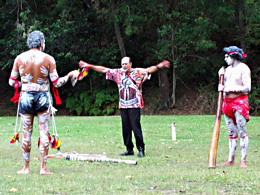 ISCEV Olympics: Vaegan introduces the Aborigines' performance |
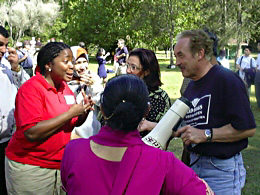 A complaint lodged by the leader of the American team is being seriously considered |
||
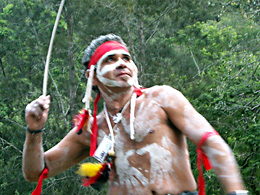 The master throws a boomerang– |
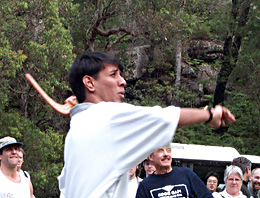 and Mohan Ram follows suit, as yet unaware that he will receive the Dodt award |
||
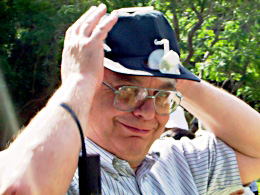 John Robson uses my solar-driven propeller cap to cool himself under Australia's sun |
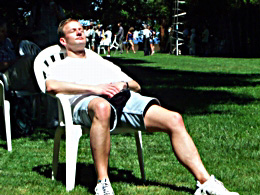 Ulrich Kellner during the outing, as yet unaware that board officers duties await him |
||
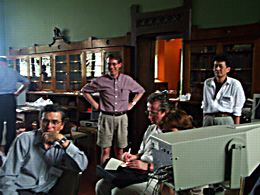 A multifocal presentation |
 Our illustrious president & a happy organiser bid us good-bye Photos and commentary by Michael Bach. |
||
| Future Symposia | top ↑ |
2002The XXXXth ISCEV Symposium will be organised by Werner Spileers in Leuwen, Belgium.
2003The XXXXIth ISCEV Symposium will be organised by Y Miyake in Nagoya, Japan.
2004For the XXXXIIth ISCEV Symposium we have an invitation by WW Dawson to Puerto Rico, by JR Heckenlively to Los Angeles, by M Brigell to Ann Arbor and by A Fulton to Boston.
2005A sizable contingent of participants from Egypt has reinforced a long-standing invitation from Massoud to Cairo, Egypt. |
|
| ISCEV Standard Revisions | top ↑ |
| PERG | |
I would like to thank the membership for the confidence in the proceedings of the PERG committee and the vote for publication. The PERG standard is now published [Bach M, Hawlina M, Holder GE, Marmor M, Meigen T, Vaegan, Miyake Y. Standard for Pattern Electroretinography. Doc Ophthalmol Doc Ophthalmol 2000;101:11-18] and also available on-line at <www.iscev.org/iscev/standards/index.html>. Michael
Bach, PhD, Chair PERG standardisation Committee |
|
| VEP | |
It is time to revise the ISCEV VEP standard. There was a meeting to discuss changes at the meeting in Israel and in Sydney. There are still a number of open issues. Therefore, we have scheduled further meetings during the Canadian meeting. J. Vernon Odom, PhD, Chair VEP standardisation Committee |
|
| Multifocal ERG | |
A draft of the multifocal guidelines has been available on-line for ISCEV members. During the Canadian Symposium copies will be available, and a discussion meeting has been scheduled. We hope that the membership can vote on the guidelines at Orford. Michael F. Marmor, MD, Chair mfERG
standardisation Committee |
|
| Calibration Guidelines | |
Finally, it is time to revise the Calibration Guidelines. The committee has convened during the ARVO 2001 and hammered out further issues via email. A draft of the revised multifocal guidelines (2001) has been available on-line for ISCEV members. During the Canadian Symposium a discussion meeting has been scheduled and we look forward to the finishing touches. Mitchell Brigell, PhD, Chair Calibration Guidelines Committee |
|
| Web News | top ↑ |
We established our ISCEV web site since 1996 and in 1999 we acquired the internet domain <www.ISCEV.org>. We have just prolonged our claim to this domain for 9 years. Apart from information about our society, the web site provides direct access to the ISCEV standards. Amongst others, you will find there a list with the members' email addresses, and homepages, if known. As every year, I pledge your help in checking your (and your colleagues) entries there, since we miss a lot and also get a sizable number of address errors when sending ISCEV information to all members via email. On our website there is also a pointer to the ISCEV on-line discussion list, "CEVnet". It has met with considerable success since going on-line in January 2001. The list manager, Scott Brodie, reported on the early experience with the list at ISCEV@ARVO. An additional feedback session is planned for the annual meeting in Quebec. Dr Brodie plans to offer summaries of the CEVnet discussions as a regular feature in Doc Ophthalmol. My goal still is to provide a site with more content than glitz, loading rapidly, scalable to all screen sizes, and not relying on fancy features of the most recent browser version. Please check it out; I welcome constructive critiquing. Michael Bach, PhD, Director of International Communication |
|
| Obituaries: Fried van Lieth and Jens Röver | top ↑ |
| With deep sadness we announce that 'Fried Van Lith passed away on 13 March 2001. Godefridus (Fried) van Lith was born in 1931. He studied medicine at the State University of Utrecht and started his training in ophthalmology in 1961 at the Rotterdam Eye Clinic, where at that time Harold Henkes had recently been appointed as Professor of Ophthalmology. Prof Henkes writes: "Fried was my first resident and soon it was obvious that his special interest lay in clinical electro-ophthalmology, at that time merely consisting of electroretinography and oculography. It was clear to me that further development in the field had to be gained in a research institute. Due to the fact that I was friendly with Eberhart Dodt, Fried was invited for a sabbatical year at the Kerckhoff Institute in Bad Nauheim. After his return from Germany, Fried joined the staff of the Rotterdam Eye Clinic and at the same time took over the supervision of the department of electro-ophthalmology." Prof Zrenner writes: " He was one of the first clinicians and scientists in my development as a researcher and clinician, whom I met at the ISCEV conference in Bad Nauheim in 1973, when I had been working just a few weeks in the field in which I am working now. He impressed me very much by his clear thought, dedication to the topic, dedication to application of scientific results in patients and his crisp diagnosis of the problem in the patient." |
 |
In the years following his return from Germany, 'Fried not only expanded the department of the Rotterdam Eye Clinic, but on invitation, set up a similar unit at the ophthalmic clinic of Leiden University. He also advised in the setting up of small units in ophthalmic departments in several large general hospitals in Holland. In addition he was consultant to the Inter-university Ophthalmic Research Institute in Amsterdam. In 1974 he took over the directorship of the Rotterdam Eye Clinic, a position he held till 1990. In 1984 'Fried was appointed extra-ordinary professor in electro-ophthalmology at the Rotterdam University. In our Society, we know him not only for his scientific and clinical work, but also because he was Secretary-General of ISCEV from 1972 to 1978, and his dedicated work helped bring this Society from humble beginnings into an internationally powerful organisation, fostering science and very much improving patient care. He was a member of the International Standardisation Committee for Visual Electro-diagnostics. From 1978-1981 he was Editor of Documenta Ophthalmologica and Editor of Ophthalmic Research. Fried was author or co-author of more than 100 publications in his field of interest including doctor's theses for the PhD-degree, not only for students of the Rotterdam, but of other universities as well. Regularly, students from all over the world found their way to Rotterdam for a short or a long stay at the Eye Clinic. Thereby, he gained great respect and he developed the field of function testing in patients, especially with retinal degenerations and optic nerve diseases, into a well-recognised and useful discipline Thousands of patients have been helped directly, and many times that number indirectly, by improved medical practise in many countries. We are all very grateful to 'Fried and we will never forget him. Compiled by Colin Barber from material supplied by Harold Henkes and Eberhart Zrenner. |
|
| We regret to inform you all that our friend Jens Röver passed away recently in a tragic glider crash. Jens was an active member of our society of long-standing, attending many meetings and serving as an officer in a role to elicit financial support from corporate members. His lab was one of the very few worldwide in which the ERG c-wave was routinely recorded clinically. On a more personal note, Jens was my (Michael's) admired teacher when I entered Electro-Ophthalmology, patiently explaining pathology and reviewing patient records with me. I owe him the deepest thanks and warmest affection for introducing me to this field, and also to ISCEV. It was a pleasure to continue working with him when he left Freiburg, since we still had joint teaching duties. For over 25 years, I (John) spent many intimate moments with Jens as we often stayed together in the same room while attending ISCEV and other international meetings. He became for me the symbol of my German ancestry, and the source for whatever abilities I have in the language. We will miss him. Our thoughts go towards his wife Elke, and to their two children, to help them sustain this grave loss. Michael Bach, John Siegfried |
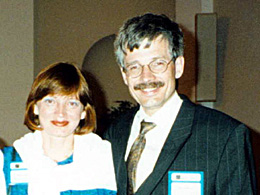 |
| WWW.ISCEV.ORG | Standards | Links | ISCEV | ![[ISCEV logo]](../../images/logo74.gif) |
||||
| Symposia | Courses | About | |
|||||
| Newsletter | Members | Misc |
PresidentY Miyake, (-2002/1)
Secretary-GeneralColin Barber
Vice-presidentsWW Dawson (Americas)
Secretary for the AmericasRG Weleber
Secretary for Asia and AustraliaY Oguchi
Secretary for Europe/AfricaU Kellner |
TreasurerE Adachi
EditorJV Odom
Members-at-largeM Bach
Advisory Board MemberE Zrenner
HONORARY MEMBERS
|